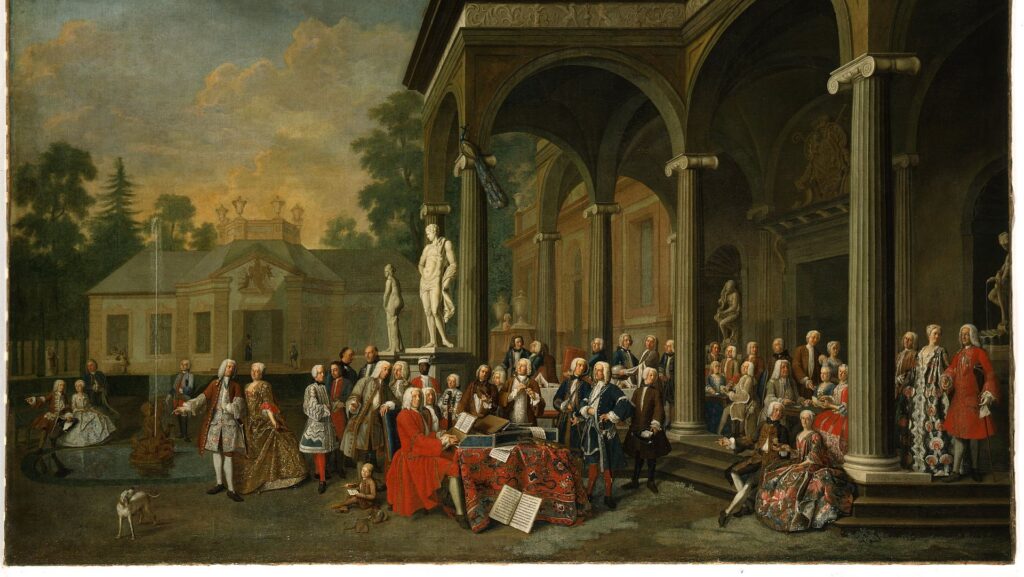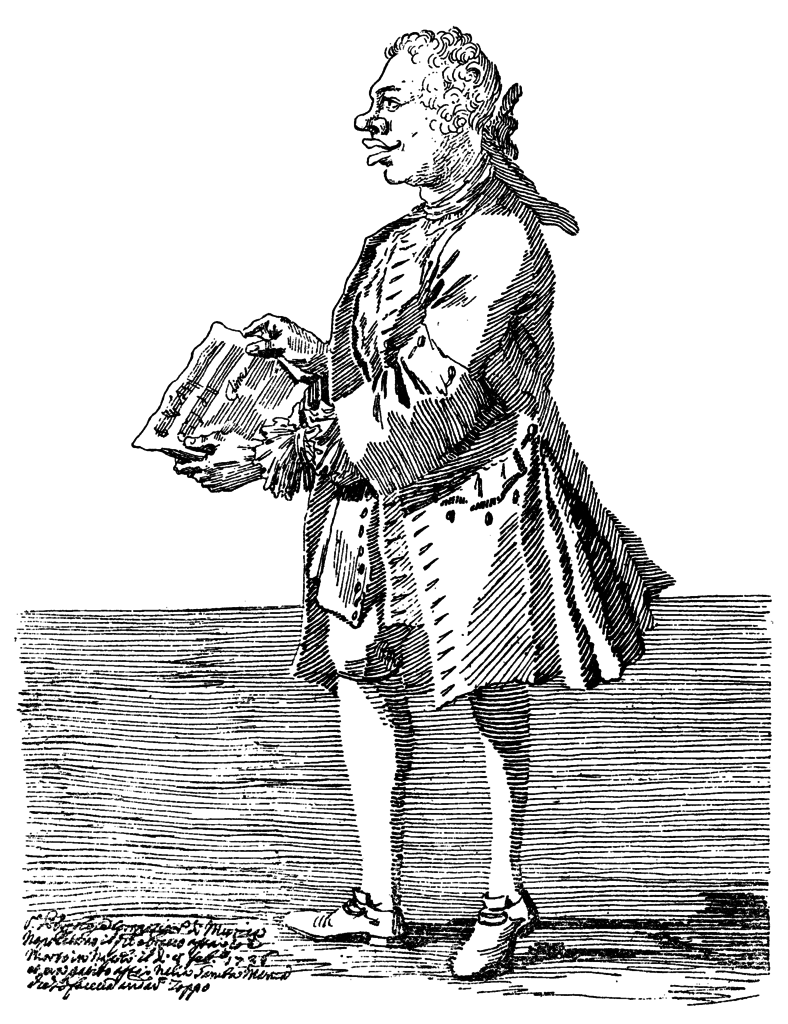
Court Concert at Ismaning Palace (1733), a 186 x 240,5 cm oil on canvas by Peter Jakob Horemans (1700-1776), located in Bayerisches Nationalmuseum in Munich. The court society is gathered in front of the summer palace of the prince-bishops of Freising at Ismaning. While the table is being laid and the guests play cards at one of the gaming tables, a group is gathered around the castrato singer Filippo Balatri seated at the harpsichord. The host, Prince-Bishop Johann Theodor, leans casually on the back of the musician’s chair.
Photo: Bayerisches Nationalmuseum, CC BY-NC-ND 4.0
I have spent my career debating Marxists of all shades. One small dose of Hegel and history is usually enough to sober them up. In our Gothic world of theoretical hallucinations, there is not even a chance of genuine debate. One must either consent to the hallucination or else shut up.
Duni and Pergolesi were both engaged to Rome for the Carnival season in the year 1735. Both had to compose a new opera: Pergolesi the first opera, L’Olimpiade, and Duni the second, Nerone. Knowing his competitor’s superior genius and far more profound art, Duni confessed this to Pergolesi, as well as his fear, which had prevented him from putting a note on paper, when Pergolesi’s opera was already being rehearsed for the first time. Immediately after the first rehearsal, Duni went to see Pergolesi. “Dear friend,” he said to him, “your opera is full of exceptional but very personal beauties. In a private room they would produce a magnificent effect, but in the theatre one cannot notice them. […] Now I am writing my opera, which will certainly not be worth nearly as much as yours, but will be all the more successful.” Duni’s prediction came true: L’Olimpiade became a total flop, Nerone a huge success.
—C. F. Müller, Musikalische Original-Anekdoten und Miszellen, Erfurt, 1836, p. 303.
Although it is often impossible to determine exactly what in an anecdote is Dichtung and what is Wahrheit, the above anecdote seems to have a solid historical basis, albeit perhaps somewhat idealising Duni’s exemplary collegiality. Indeed, Giovanni Battista Pergolesi (1710-1736) and Egidio Duni (1708-1775) wrote their serious operas L’Olimpiade and Nerone shortly after each other in 1735 for the same Teatro di Tordinona in Rome. The singers were therefore partly the same for both works. The Walloon composer André Grétry, who recorded the anecdote from the mouth of Duni himself, adds that an angry theatregoer even threw an orange at Pergolesi’s head while the latter was conducting the performance of L’Olimpiade from behind the harpsichord. Such misbehaviour was indeed not unusual in Italian theatres. The Dutch traveller Jan Alensoon mentions in his travel diary that in Venetian theatres he preferred to sit in the middle of the parterre as much as possible, in order not to be targeted by the ladies (!) who, from their boxes, fired on the visitors below with spit and ‘other filth.’
Both Pergolesi and Duni are referred to in the libretti of their operas as ‘maestro di cappella napoletano’ (‘Neapolitan chapel master’), although neither of them was born in Naples. They both did, however, receive their musical training in that city, under the guidance of the renowned composer and teacher Francesco Durante, among others.
Opera music from Naples set the tone in all Italian theatres from about 1725 onwards. Even in Venetian opera theatres, local composers like Albinoni and Vivaldi were increasingly supplanted by Naples-trained composers. The lovely and gallant music of the young ‘Neapolitans’ was referred to as the ‘dolce stil nuovo’ (‘the lovely new style’) and was seen by many connoisseurs across Europe as the epitome of good taste. I am always struck by the fact that most Naples-trained composers seem to have a more profound feeling for the human voice than most of their Venetian contemporaries. Composers like Johann Adolf Hasse (1699-1783, nicknamed ‘il caro Sassone,’ ‘the beloved German’) and Leonardo Vinci (ca. 1690-1730, not to be confused with Leonardo da Vinci) know exactly how to make the most of a singer’s qualities.
This was therefore the time when Italian castrato singers celebrated their greatest triumphs. With their powerful ‘silver’ voice and highly developed lungs, they seem to have easily filled even the largest theatres. Carlo Broschi in particular, nicknamed ‘il Farinelli,’ achieved the highest perfection according to his contemporaries. He possessed a voice that was called lovely, strong, and penetrating, with an unprecedented compass of more than three octaves. All over Europe, therefore, he celebrated triumphs and earned never-before-paid fees for singers. Given that fact, it is understandable that many opera lovers write about him in the most ecstatic terms, often without mentioning the name of the composer of the opera in question! Just as today, many people remember which great actor shines in a particular film but do not know the name of the director. But the popularity of castrato singers had its downside. In the autobiography of Farinelli’s companion, the castrato singer Filippo Balatri, the author struggles with his history and identity. What should he answer to the frequently asked question of whether he is a man or a woman? Balatri articulates the feelings he experiences at such moments in the following poignant verse:
I’m struggling for an answer terribly.
Do I say ‘a man’?” The lie is banal.
Do I say ‘a woman’? No, that needs no argument.
I get a colour and say: neutral.
Is it any wonder that Balatri clenches his fist, thinking about what has been done to him, and exclaims, “Mondo Porco! Mondo Perverso! Mondo Canaglia!” (“Swine world, perverse world, scum world!”)?
According to Pergolesi’s first biographer, the composer is said to have retired to a monastery in Pozzuoli, just north of Naples, in early 1736, less than a year after the failure of L’Olimpiade. There he died of tuberculosis on March 16, 1736, aged 26 years, two months, and 12 days.
An international Pergolesi cult emerged after Pergolesi’s early death. Two works in particular brought the composer posthumous worldwide fame: the comic opera La serva padrona—actually two ‘intermezzi’ (‘interludes’) sung during the two intervals of a full-length serious opera in three acts—and the Stabat mater. In La serva padrona, the cunning housekeeper Serpina—the name is reminiscent of the Italian word ‘serpente’ (‘serpent’)—ensnares the wealthy unmarried Uberto in her marital nets, with some help from her accomplice Vespone, a character who is present on stage but does not sing. Serpina eventually gets her way, but the final duet by no means sounds like an emotional love duet but rather like a ‘ceasefire.’ For this reason, after the premiere, the final duet was regularly replaced by the final duet from Pergolesi’s cheerful opera Il Flaminio, which did give the audience the reassuring feeling of ‘all’s well that ends well.’
After a performance of La serva padrona in Paris in 1752, an extremely heated debate ensued between proponents of Italian music and supporters of French opera. The philosopher Jean-Jacques Rousseau, in particular, vehemently criticised the ‘overloaded’ music of Rameau and other French composers, citing the music of ‘ce grand musicien’ Pergolesi as the prime example of expression and good taste.
But even La serva padrona could not match the legendary fame that Pergolesi’s Stabat mater would harvest. Carlantonio De Rosa, Marquis of Villarosa, Pergolesi’s first biographer, writes that the composer composed his setting of this mediaeval lament about the Virgin Mary standing at the foot of the cross in the last year of his life. It was commissioned by the noble Archconfraternity of the Seven Sorrows of Mary (‘Arciconfraternità della Vergine dei Dolori’). The gentlemen had been using Alessandro Scarlatti’s old setting for many years and were clearly in need of something new. The composer himself seems not to have been completely satisfied with his work. Some critics were of the same opinion, as some parts of the Stabat mater were considered to be lacking in seriousness and devotion to their ears. In other words, the Stabat mater sounds sometimes too much like La serva padrona, especially in the ‘Eia mater’ movement.
German composer Ferdinand Hiller, who expressed his reservations about Pergolesi’s Stabat mater to Rossini in 1855, received an answer as characteristic as it was wise from the old Italian maestro. After telling Hiller that he was initially reluctant to publish his own Stabat mater because Pergolesi’s setting enjoyed such great renown everywhere, Rossini added:
I had it [Pergolesi’s Stabat mater] performed in Naples [in 1820], and it made a deep impression. But it requires two beautiful voices, they must recite it well and even lend a hand here and there to some somewhat outdated passages by noble expression. The original simple instrumentation must also be respected. Recently, people performed it with large choirs and in a modern orchestration. I don’t know where that was, but it is a completely misguided undertaking.
But however critical some connoisseurs sometimes were of Pergolesi’s Stabat mater, no one could ignore the work, as it moved music lovers to tears across all Europe. Spanish composer Juan Francés de Iribarren Echevarría (1699-1767) felt compelled to make all sorts of minor rhythmic, melodic, and harmonic adjustments to Pergolesi’s score. Iribarren additionally used the music of movements from Pergolesi’s Stabat mater several times as the basis for short religious motets.

Composer Giovanni Gualberto Brunetti (1706-1787), who worked in Pisa, did something similar and even went a step further: his Stabat mater is an imaginative imitation of Pergolesi’s masterpiece. Sometimes Brunetti adheres strictly to his example; sometimes he reverses everything (a rising motive in Pergolesi then becomes a falling motive in Brunetti, for example). At other times, Brunetti uses only one rhythmic element from Pergolesi or even detaches himself completely from his venerated example. Finally, Johann Sebastian Bach, who himself usually composed in a much more traditional style, made an arrangement of it—to my ears, frankly, a sometimes needlessly complex one—in which the original Latin text gave way to an incomplete German-language version in rhyme of Psalm 51 (Psalm 50 in the Vulgate): Tilge, Höchster, meine Sünden BWV 1083.
Pergolesi’s posthumous fame had some unpleasant consequences: publishers and copyists everywhere were selling works by other composers under Pergolesi’s commercially attractive name. When Stravinsky completed Pulcinella in 1920, he was under the impression that he had quoted and arranged 20 pieces by Pergolesi in his ballet music. It has since emerged that, in fact, 11 of the examples used by Stravinsky in Pulcinella were by lesser-known composers such as Carlo Monza, Domenico Gallo, and the Dutchman Count Unico Wilhelm van Wassenaer.
There are many fine recordings of the Stabat mater. My current favourite is the one with Julia Lezhneva (soprano), Philippe Jaroussky (countertenor), and I Barocchisti conducted by Diego Fasolis (Erato). Strangely enough, I do not know of any recording of La serva padrona that convinces me in all respects. I like the recording with Patricia Biccire (soprano), Donato di Stefano (bass), and La Petite Bande conducted by Sigiswald Kuijken, which has the great advantage of involving two singers whose mother tongue is Italian (Accent). Moreover, the same CD also offers a recording of Pergolesi’s Livietta e Tracollo, whose title was originally La contadina astuta. Those wishing to hear Pergolesi at his most monumental would do well to purchase the Rinaldo Alessandrini-led performance of the impressive Messa di Sant’Emidio, even if the performance does not fully convince (Naïve).